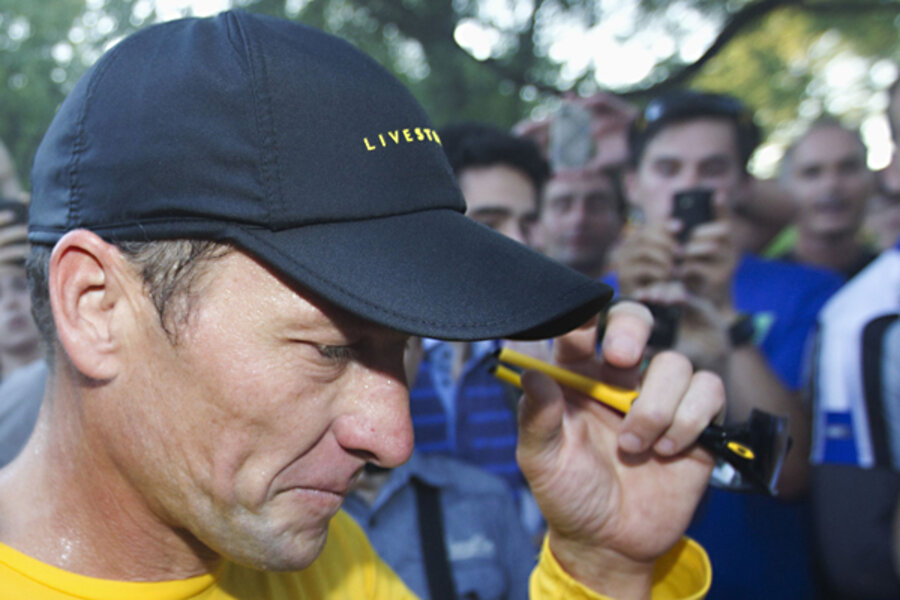Nike drops Lance Armstrong. Is his net worth in jeopardy?
Loading...
At latest count Lance Armstrong lost four jobs Wednesday: as chairman of his charity and pitchman for three of his biggest sponsors. But how much will his finances be affected?
For the most part. the fall of Armstrong from a paragon of athletics and charitable good works to the ringleader of a highly sophisticated doping conspiracy has been a gradual affair, taking shape with incremental revelations coming to light over several years.
But the decline of his reputation has accelerated over the past few months. In September, the seven-time Tour de France winner announced he would no longer fight doping charges made against him by the US Anti-Doping Agency, leaving the agency free to strip Armstrong of his titles and winnings and ban him from professional cycling for life.
Last week, the USADA released a 1,000-page report detailing its case against the cyclist, presenting what it called “conclusive and undeniable proof that brings to the light of day for the first time this systemic, sustained and highly professionalized team-run doping conspiracy.” The USADA is sending its report to international governing bodies for cycling as well.
And today, Nike, RadioShack, and Anheuser-Busch said they were dropping Armstrong as a spokesman, just as he announced he will be stepping down as chairman of Livestrong, to help distance the charity from the doping controversy.
“Due to the seemingly insurmountable evidence that Lance Armstrong participated in doping and misled Nike for more than a decade, it is with great sadness that we have terminated our contract with him,” the company said in a press release. “Nike does not condone the use of illegal performance enhancing drugs in any manner.”
While it's clear that Armstrong’s image has been dealt a heavy blow, it’s less clear what effect that will have on his pocketbook – or Livestrong’s.
As of 2012, Armstrong’s net worth is estimated at $125 million. As a retired cyclist, he makes an estimated $10 million annually from speaking engagements and endorsements, according to Forbes. Nike wouldn’t disclose the terms of Armstrong’s terminated endorsement deal, but he made $17.5 million from endorsements in 2005 – the last year such earnings were made public. From an endorsement standpoint, Armstrong is likely at the end of the road. Athletes like Kobe Bryant and Tiger Woods have maintained sponsorships in the wake of scandals, but Armstrong is retired, with little chance of redeeming himself through athletic heroics. Without that, he isn’t much use to a sneaker company.
What’s more, Armstrong may have to give back some, if not all, of his earnings from professional cycling. The French Cycling Federation has as already issued a statement in support of the USADA’s findings and requested that Armstrong return €2.95 million (nearly $3.9 million) from winnings in the Tour de France and other cycling competitions. If the International Cycling Union (UCI) and other governing bodies for the sport follow suit, Armstrong could be out tens of millions in earnings.
He’s also susceptible to a slew of lawsuits. On Tuesday, Britain's Sunday Times newspaper confirmed that it is considering suing Armstrong for a libel lawsuit settled with the cyclist in 2006, in which it had to pay him €600,000 in damages. The potential for similar legal action is vast.
But Livestrong may be spared, at least in the short term. Since its founding in 1997, the charity has raised just under $500 million for medical research and sold several millions in merchandise (just a short while ago, the foundation’s trademark rubber yellow bracelets were ubiquitous). Nike is maintaining its sponsorship, and donations have not yet been affected. In fact, according to the San Francisco Chronicle, donations spiked 25 percent the day Armstrong was banned from cycling.
Still, whether Livestrong can maintain its relevance and pull without its now-disgraced figurehead will take years to see fully.






